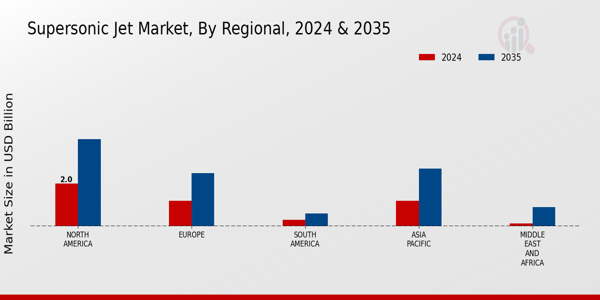Market Growth Projections
The Global Supersonic Jet Industry is poised for substantial growth, with projections indicating a market size of 4.83 USD Billion in 2024 and an anticipated increase to 9.8 USD Billion by 2035. This growth trajectory suggests a compound annual growth rate of 6.64% from 2025 to 2035, reflecting the increasing interest in supersonic travel solutions. The market dynamics are influenced by various factors, including technological advancements, consumer demand, and regulatory changes. These projections underscore the potential for significant investment and innovation in the supersonic jet sector, as stakeholders seek to capitalize on the evolving landscape of air travel.
Technological Advancements
The Global Supersonic Jet Industry is experiencing a surge in technological advancements that enhance aircraft performance and efficiency. Innovations in aerodynamics, materials science, and propulsion systems are pivotal in reducing drag and increasing fuel efficiency. For instance, the development of new composite materials allows for lighter aircraft structures, which can improve speed and reduce operational costs. As a result, the market is projected to reach 4.83 USD Billion in 2024, with these advancements driving consumer interest and investment in supersonic travel. The ongoing research and development efforts by major aerospace companies indicate a promising future for this segment.
Investment in Infrastructure
The Global Supersonic Jet Industry is benefiting from increased investment in aviation infrastructure, which is crucial for the development and operation of supersonic travel. Airports are beginning to adapt their facilities to accommodate supersonic jets, including the construction of specialized runways and terminals. This infrastructure development is essential for ensuring safety and efficiency in supersonic operations. Furthermore, government initiatives to enhance airport capabilities can facilitate the growth of the market, as they provide the necessary support for new aircraft technologies. As infrastructure improves, the market is likely to see accelerated growth, fostering a conducive environment for supersonic travel.
Rising Demand for Faster Travel
The Global Supersonic Jet Industry is witnessing a growing demand for faster travel solutions, particularly among business travelers and affluent consumers. The desire to minimize travel time has led to increased interest in supersonic jets, which can significantly reduce flight durations. For example, a flight from New York to London could potentially take under three hours, compared to the typical seven hours for conventional jets. This demand is reflected in the projected market growth, with estimates suggesting a rise to 9.8 USD Billion by 2035. The appeal of time-saving travel options is likely to drive investments and innovations in this sector.
Consumer Awareness and Acceptance
The Global Supersonic Jet Industry is experiencing a shift in consumer awareness and acceptance of supersonic travel. As information about the benefits of supersonic jets becomes more widespread, potential customers are increasingly recognizing the advantages of faster travel times and enhanced comfort. Marketing efforts by aerospace companies are focusing on educating consumers about the technological advancements that make supersonic travel feasible and safe. This growing acceptance is likely to translate into increased demand, contributing to the market's projected growth. As consumer perceptions evolve, the market may see a significant uptick in interest and investment, further solidifying its position in the aviation sector.
Environmental Regulations and Sustainability
The Global Supersonic Jet Industry is increasingly influenced by environmental regulations and the push for sustainable aviation solutions. As governments worldwide implement stricter emissions standards, the aerospace sector is compelled to innovate. Supersonic jets are being designed with eco-friendly technologies, such as sustainable aviation fuels and noise reduction systems, to comply with these regulations. This shift not only addresses environmental concerns but also enhances the market's appeal to environmentally conscious consumers. The industry's commitment to sustainability could be a key driver in achieving a compound annual growth rate of 6.64% from 2025 to 2035, as it aligns with global sustainability goals.






















Leave a Comment